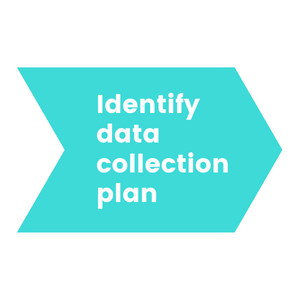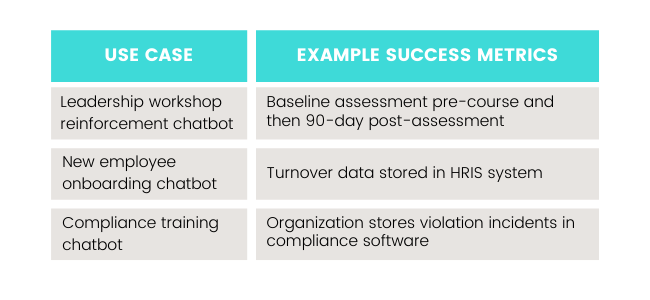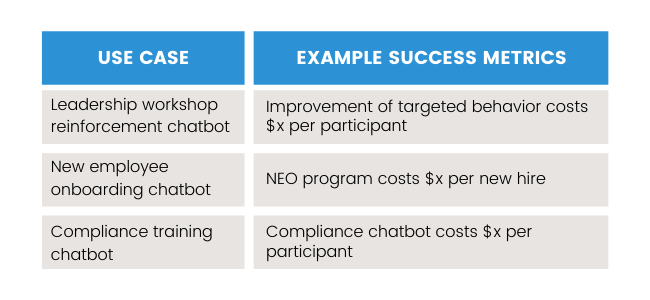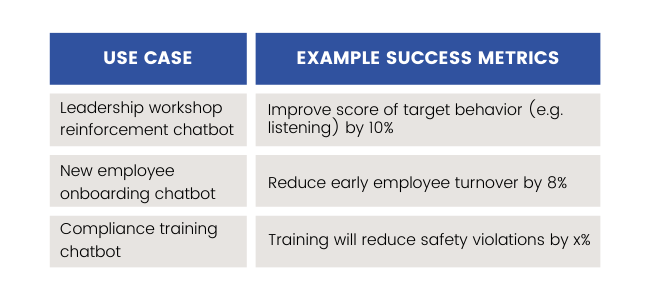The ROI Formula
The ROI Formula

We’ve put together this simple ROI formula to help L&D professionals make their case for a chatbot project. If you follow this formula, you’ll be able to make a better case to your stakeholders and leadership about why they should fund a chatbot project, and you’ll also have a clearer sense of the difference the chatbot makes for your organization.
How do you use the Formula?
- Define success upfront so you’ll know it when you see it.
- Any ROI plan will require data or inputs to measure the results, so be sure you know from the beginning how you will collect and measure the data necessary for your success metrics.
- Compute the program cost. How much will it take to build and deploy your chatbot? Another way to think of this step is to ask, “How much am I spending to buy my success metric?”
- Lastly, you need to create a business case to use to communicate the ROI formula to stakeholders. This can be formal or informal but is a vital part of being successful. We recommend you create an “elevator pitch version” as well as a fuller more robust version. Mobile Coach has a template for a formal business case you can access here.
Step 1: Define Success Metrics

As mentioned, it’s important to agree on success metrics in advance. Some common categories for success metrics include:
- Measuring content retention
- Tracking behavior change
- Learner engagement with the chatbot
- Participants’ opinions about the program

Step 2: Identify Learning Data Collection Plan

Data collection is often the most difficult part of the formula as many people have less control over existing data collection methods, or little data is currently collected.
The good news is that chatbots are a great mechanism for data collection. Instead of using an online survey, a chatbot can create a conversational series of questions over time that increases the quality of the qualitative data from participants. Chatbots can also ask more than just survey questions. They can benchmark user actions and track behavior, allowing you to capture more information than other methods.
Just like every step in this formula, you should make sure that all stakeholders agree on the data collection plan in advance. Getting folks on board with the entire formula is important, but this step, in particular, can make or break the success of your ROI measurement.

Step 3: Compute Program Cost

Your organization likely already has a framework for how you budget for programs. For chatbot projects the two major cost categories are:
- Chatbot design, configuration, deployment
- User fees

Step 4: Create Business Case

We’ve found that creating the business case can sometimes be the most intimidating for L&D professionals as they are experts in instructional design but not necessarily in business. The more practice you get, the better you’ll become!
Tips for preparing a business case:
- Your elevator pitch should be clear and simple. If you can’t memorize it, it’s too long and complicated!
- Having an extended version of your elevator pitch lends credibility and demonstrates the rigor you need to convince senior management to approve your program.
- Put together some slides to make your case.
- Practice selling your business case with others and be willing to adjust as you receive feedback. Receiving feedback thoughtfully is part of the rigor you’ll need to build your business case. By the time you get to the final decision maker, you’ll have already answered all the common questions that they’ll have!
- Finally, the better the business case, the easier it is to insist that the decision to approve your program be decided on the business case itself, not on personal opinions about the training.

We recommend you to watch our webinar “How to Build a Business Case for a Chatbot Project” where Vince Han, CEO & Founder of Mobile Coach, walks through a template chatbot business case that you can use to promote a chatbot project.
Get a Demo
Learn how Mobile Coach chatbots will help you drive real engagement with your audience to achieve the key behaviors and results you want.





